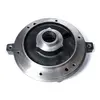Mobile:+86-311-808-126-83
Email:info@ydcastings.com
Properties and Applications of Martensitic Stainless Steel Castings in Modern Engineering
Martensitic Stainless Steel Castings An Overview
Martensitic stainless steel castings represent a unique segment of the stainless steel family, characterized by their magnetic properties, high strength, and excellent wear resistance. They find widespread application in various industries, notably in the manufacturing of components that require high hardness and corrosion resistance. This article aims to explore the composition, properties, manufacturing processes, and applications of martensitic stainless steel castings.
Composition
Martensitic stainless steels are primarily composed of iron, chromium, and carbon. The chromium content typically ranges from 12% to 18%, which contributes to their corrosion resistance, while the carbon content can vary from 0.1% to 1.2%. Other alloying elements like molybdenum and nickel may also be included to enhance specific properties such as toughness and strength. The unique combination of these elements allows martensitic stainless steel to achieve a hardened structure known as martensite when subjected to appropriate heat treatment.
Properties
The properties of martensitic stainless steel castings make them suitable for applications that demand high strength and corrosion resistance. Key characteristics include
1. High Hardness Martensitic stainless steels can reach high hardness levels after heat treatment, making them ideal for components that undergo significant mechanical stress.
2. Good Corrosion Resistance While not as resistant to corrosion as austenitic stainless steels, martensitic variants still provide reasonable protection against oxidation and corrosion, particularly in mildly corrosive environments.
3. Magnetic Properties Unlike austenitic stainless steels, martensitic grades are magnetic, which can be advantageous in certain applications such as magnetic separation systems.
4. Good Wear Resistance Their hardness contributes to excellent wear resistance, which is particularly beneficial in applications subjected to abrasion.
5. Toughness While they exhibit high strength, martensitic stainless steels can be susceptible to brittle fracture, particularly in specific heat-treated conditions. Therefore, careful control of heat treatment processes is essential to optimize toughness.
Manufacturing Processes
The production of martensitic stainless steel castings typically involves several steps
1. Melting The raw materials, including the necessary alloying elements, are melted in an electric arc furnace or induction furnace. This high-temperature process ensures a homogenous melt.
martensitic stainless steel castings

2. Pouring Once the molten metal reaches the desired temperature, it is poured into pre-prepared molds to shape the castings.
3. Cooling After the metal solidifies, it is cooled to room temperature. The cooling rate can significantly influence the microstructure and, consequently, the properties of the final casting.
4. Heat Treatment This step is crucial as it transforms the initial microstructure into martensite through quenching. The castings may also undergo tempering to reduce brittleness and enhance toughness.
5. Finishing Finally, castings undergo finishing processes, which may include machining, surface treatment, and inspection to meet specific tolerances and quality standards.
Applications
The unique properties of martensitic stainless steel castings make them suitable for various applications across multiple industries
1. Aerospace Components such as landing gear and structural parts that require high strength and reduced weight benefit from martensitic stainless steel castings.
2. Automotive Parts subjected to high wear, such as valves, gears, and pump components, often utilize martensitic stainless steel due to its hardness and wear resistance.
3. Oil and Gas These castings are employed in pumps, valves, and fittings due to their robustness and ability to withstand harsh environmental conditions.
4. Medical Tools Surgical instruments that require sterilization and corrosion resistance frequently leverage the characteristics of martensitic stainless steel.
5. Industrial Equipment Components in manufacturing machinery that are exposed to abrasion can greatly benefit from the wear resistance of martensitic stainless steels.
Conclusion
Martensitic stainless steel castings represent a vital category of materials in modern manufacturing. Their combination of strength, hardness, and reasonable corrosion resistance, coupled with versatile manufacturing processes, makes them invaluable in various high-performance applications. As industries continue to demand materials that can withstand extreme conditions while maintaining integrity, martensitic stainless steel castings will play a crucial role in meeting these challenges.
-
Understanding Metal Casting TechniquesNewsApr.02,2025
-
Understanding Exhaust Manifolds for Enhanced Engine PerformanceNewsApr.02,2025
-
The World of Metal FabricationNewsApr.02,2025
-
Key Components for Pump and Turbo EfficiencyNewsApr.02,2025
-
Essential Tools for Automotive Maintenance and RepairNewsApr.02,2025
-
Durable Valve Components for Effective Water ManagementNewsApr.02,2025











